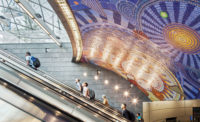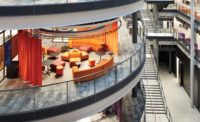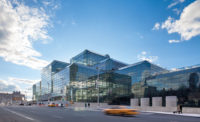Brain power is physical. Just as exercise builds a child’s muscles, bones, heart, and lungs, so it builds the brain, fueling cells with oxygen, nourishing connections between neurons, and supporting new neuron growth. Yet only one in three American children is physically active daily; fewer than one in seven walks or bikes to school; and, according to a new study from Harvard University’s T.H. Chan School of Public Health, over half are on a track that will lead to obesity by the time they are 35. Schools, where kids spend up to half their waking lives, represent a major opportunity to develop children’s brains, and their health overall, by getting them moving.
Movement doesn’t necessarily mean sports or athletics. Research shows that activities of low to moderate intensity can affect overall energy levels and help prevent weight gain; just reducing the amount of time spent sitting, and breaking up that sitting time with movement, makes a difference. Even so, a 2011 study of activity levels among 8- to 11-year-olds over the course of a school day found they were sedentary for 70 percent of class time, including gym class, and most were also inactive during recess and lunchtime. Aiming to do better, three recent K–8 schools—Discovery Elementary in Arlington, Virginia; Northland Innovation Center for Students in Academically Gifted Education (SAGE) in Gladstone, Missouri; and St. Hilda’s & St. Hugh’s School in New York—use design to foster less sedentary behaviors.
Discovery Elementary, a 98,000-square-foot net zero energy school, implements lessons from the experience of its architect, Charlottesville-based VMDO, on an earlier, health-driven project, Buckingham County Primary+Elementary Schools, in central Virginia. That project gave rise to Healthy Eating Design Guidelines for School Architecture, adopted by the Centers for Disease Control and Prevention and, more recently, the complementary Physical Activity Design Guidelines for School Architecture.
The Physical Activity Design Guidelines provide a set of evidence-based objectives and strategies organized according to 10 domains, including siting, massing, various progam areas, wayfinding, and furniture. “Developing the guidelines helped us to recognize all the different spatial domains that could be rethought in terms of active design,” says coauthor of the guidelines Dina Sorensen, former project designer at VMDO and now K–12 education design leader at DLR Group. “It helped us understand how promoting activity across every space could transform a school into a new type of health-delivery system.”
At Discovery, in order to preserve playing fields and open space, which are a valued community asset, on the 25-acre site (it also shares them with an existing middle school), designers set the two-story building into the side of a hill. This parti results in a compact, vertical scheme with multiple changes of level, which the design exploits to foster “active navigation,” one of the domains of the Physical Activity Design Guidelines, including strategies like prominently located, visually appealing stairs. “There are a lot of reasons teachers might choose not to move very often— usually to protect curriculum time,” says Sorensen, “so this idea of moving as a default behavior, encouraged by some amazing kid-centric features throughout the space, is very powerful.”
Immediately inside the main entry, the floor level steps down 30 inches; a guardrail-height millwork partition known as the “hedge” separates the two levels, enclosing the kindergarten zone’s “backyard.” The hedge, which is up to 4-feet deep in some places, is populated with child-size cubbyholes that kids can discover, claim, and use in various ways. The architects expected these opportunities to climb up, crawl under, slide down, or adopt an unusual posture while working to be “just a little-kid thing,” says Wyck Knox, a principal at VMDO, but even fifth graders have started dropping by the hedge when the kindergarten class is outside.
Throughout the building, features such as seating steps for story time, entire walls that serve as Scrabble and Lego playing surfaces, varied and adaptable furniture, and flexible spatial configurations provide opportunities to incorporate movement into the day. Choosing between a grand stair and a yellow slide between one floor and another is not a privilege or reward, “it’s simply a choice,” says Erin Russo, the school’s principal. A priority for Russo is encouraging the school’s teachers to use the building as intended: to take story time upstairs in Cloud Commons (a bright, open multilevel space that can serve as an informal amphitheater or as a group workspace), to make a presentation in a collaborative workspace known as the Blue Sky Studio, or to let kindergarteners find their own reading spot in the hedge.
Knox considers Discovery’s re-envisioning of the classroom concept to be one of the school’s biggest successes. A variety of specialized, customizable, and flexible areas, linked by programmable open spaces and clear lines of sight, increase the options for “active classrooms,” another of the guideline domains. Transparency, achieved with glass partitions instead of solid walls, enables teachers to keep an eye on children working on their own in adjacent spaces, effectively lowering the student-to-teacher ratio at times. The strategy has also allowed the school to dispense with hall passes and let the kids move around the building independently. “The concept of the classroom is no longer bound up by four walls,” says Knox.
Transparency and spatial flexibility are significant features of the Northland Innovation Center for Students in Academically Gifted Education (SAGE), which won a 2017 Excellence Award from the Center for Active Design, a health-focused leadership and advocacy nonprofit. Inserted into a newly constructed office building in Gladstone, the 33,800-square-foot SAGE Center supports active, student-led, participatory learning: students spend only 5 percent of their school day in structured lecture-style classes, with the rest used for researching, creating, performing, and socializing.
“The notion of kids’ following their passion, or path, marries nicely with the principles of active design,” says Steven Turckes, PreK–12 global practice leader at the Chicago office of Perkins+Will, designers for the project in association with Leawood, Kansas-based Hoefer Wysocki Architects. “Sitting inactive in a chair listening to a teacher lecture all day is one way of learning, but we would argue it’s not the best way. SAGE gives kids the space and the freedom to move, to explore, to experience, and to collaborate.”
The two-story facility, serving 250 K–5 students daily, consists primarily of open studio spaces in which focus areas are defined by rich colors and separated by glass partitions, or walkways marked with a change of floor material. Visual connections between neighboring learning environments encourage interdisciplinary thinking as students move throughout the space and engage a variety of settings over the course of a day.
As at Discovery, the furniture at SAGE was selected to foster a more dynamic environment: movable tables and chairs allow children and teachers to configure spaces as needed, chairs with a V-shaped back are equally functional facing forward or backward, stools designed to rock promote active sitting, padded seating-blocks double as work surfaces. Enabling these types of micro-movements turns sitting into an activity, and aligns with research findings that students learn more effectively when they’re able to move.
Turckes credits North Kansas School District’s then-superintendent Todd White (now with nearby Blue Valley School District) with making this paradigm shift possible. White provided the leadership to accomplish change: facilitating the necessary conversations, leading tours of precedent-setting facilities, and organizing workshops, such as one with an educational-furniture specialist, so teachers could experience the options and discuss their use in a range of settings.
Transforming schools to promote mobility among students necessarily promotes it among teachers too. Shifting from self-contained classrooms to a more fluid environment has helped to increase camaraderie and support a level of collaboration that, SAGE’s teachers say, didn’t previously exist. The ability to monitor and facilitate the children’s learning across a variety of workstations in the open space also enables teachers to observe one another’s classes more easily, and to share ideas. Facilities for staff include a planning room with a large table and kitchenette, and a meeting room with acoustical privacy. But without self-contained classrooms or even designated desks of their own, “the environment has challenged the school’s teachers to reconsider how they teach,” says Turckes. “It’s created a freedom that they just didn’t have before.”
Maximizing opportunities for students (and staff) to be more active in their indoor learning spaces improves the environments where they spend most of their time, but outdoor learning and play opportunities are also essential for children’s physical well-being, and their intellectual and social development. “There’s more and more focus on making these larger spaces positive from a mental health perspective,” says Sara Grant, a partner at New York–based Murphy Burnham and Buttrick Architects (MBB), “and on the need to support healthy interactions by designing them as warm, welcoming, and nurturing.”
In a 20-year series of projects at St. Hilda’s & St. Hugh’s School, MBB has been transforming a utilitarian structure in Manhattan’s Morningside Heights neighborhood into a building more sympathetic to the pre–K through eighth-grade school’s holistic, child-centered philosophy. One of these projects, a collaboration with landscape architecture firm RKLA Studio, is a rooftop play deck for the lower school (pre–K to grade three). Not just an area for outdoor activity (which in itself is something of an achievement on this tight urban site), the design uses materials and spatial composition to offer variety and choice, appeal to multiple senses, and generate a feeling of security and comfort.
The deck comprises three separate zones, each with a distinct character. A ball-play area allows children to make the big, exciting moves they can’t make indoors. A climbing zone includes fixed and changing elements that encourage adventurous and imaginative activity. A garden incorporates a planted wall and seating, and opens to views of the Hudson River; sheltered by a slatted screen from the more vigorous uses in the other two spaces, this “room” serves as a protected area for outdoor classes and quiet play.
One of the challenges that constructed urban play areas face is how to reintroduce nature and renewal so the space doesn’t get stale. All three zones of St. Hilda’s & St. Hugh’s play deck incorporate plantings; their colors, scents, and textures change with the seasons. The active ball zone incorporates banners—printed with clouds, for example, or an abstraction of trees—that can be changed to transform the character of the enclosure. Exhibits in the climbing zone are also switched out periodically: an airplane fuselage, a teardrop trailer, and a tiny tugboat are examples of real-world objects that have been stripped down and made safe for children.
The success of the play deck and other active-design interventions at St. Hilda’s & St. Hugh’s—such as a daylit stair limned with a quote from the Declaration of Independence, a climbing gym and dance studio in found space reclaimed from building services, and a range of immersive, hands-on learning environments that pre-date but nonetheless exemplify the active-classroom guidelines—is evidenced by data showing that students at the school take an average of over 8,300 steps during school hours alone, with the lower school children averaging over 10,700 steps.
Notwithstanding this success, Grant cautions designers against focusing too narrowly on physical activity, and encourages instead a more holistic approach to student health and well-being. That’s an idea that resonates at Discovery Elementary too: activity was a secondary motivation for many of Discovery’s design features, says VMDO’s Knox. “The primary motivation was the kids’ joy and happiness.” And it’s the same for the activity-promoting features at SAGE: “What we’re seeing,” says Julie Alsobrook, retired director of the program, “is that kids are happier.”
|
Continuing Education
 To earn one AIA learning unit (LU), including one hour of health, safety, and welfare (HSW) credit, read the "Continuing Education: Active Design," review the supplemental material listed below, and complete the online test. Upon passing the test, you will receive a certificate of completion, and your credit will be automatically reported to the AIA. Additional information regarding credit-reporting and continuing-education requirements can be found online at continuingeducation.bnpmedia.com. To earn one AIA learning unit (LU), including one hour of health, safety, and welfare (HSW) credit, read the "Continuing Education: Active Design," review the supplemental material listed below, and complete the online test. Upon passing the test, you will receive a certificate of completion, and your credit will be automatically reported to the AIA. Additional information regarding credit-reporting and continuing-education requirements can be found online at continuingeducation.bnpmedia.com.Supplemental Material
Abstract, Introduction, Table 1, and the "Physical Activity Design Guidelines for School Architecture” section under Results from--
Physical Activity Design Guidelines for School Architecture, by Brittin J, Sorensen D, Trowbridge M, Lee KK, Breithecker D, Frerichs L, et al. (2015).
Learning Objectives 1 Discuss the importance of physical activity for developing bodies and brains. 2 Describe the strategies outlined in the Physical Activity Design Guidelines. 3 Explain how the designs of the three featured buildings encourage students to move during the course of the school day. 4 Describe design strategies for encouraging outdoor activity for schools on tight urban sites.
AIA/CES Course #K1801A
For CEU credit, read "Continuing Education: Active Design" and take the quiz at continuingeducation.bnpmedia.com, or use our Architectural Record Continuing Education app, available in the iTunes store. structure, finishes, and other original fabric when
a building is moved.
significant buildings.
|












Post a comment to this article
Report Abusive Comment